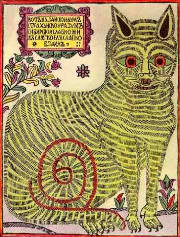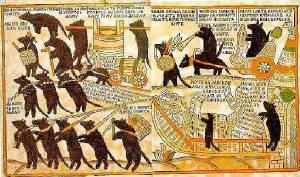|
Opposition to Peter's rule:
With the rapid modernization forced on myriad aspects of Russian life by Tsar/Emperor Peter I, many within Russian society,
especially among the Old Believers and in the countryside, came to view him extremely unfavorably. His distancing of the Church
from the state angered many and, according to the Columbia encyclopedia, "conservatives among the clergy accused him
of being the antichrist."
Their dislike of Peter was borne out in lubki of that period:

This is perhaps the most famous lubok regarding Peter, and utilizes the contemporary image used to represent him, the cat.
A clever and vicious predator, for Peter's enemies, the cat is an excellent representation of him.
The lubok is also extremely crude, commenting on Peter's lavish lifestyle while calling into question his very manhood
by charging that the cat "farts weakly."

Another lubok that utilizes the imagery of the cat, this image is particularly heroic (or petulent) in its depiction of the
mice (the Russian people) overthrowing and burying the cat (Peter).
This may have been a throwback to what were perceived as the heroic days of Stepan Razin's rebellion against the Tsar Alexis,
under whom the Old Believers split. While there is some debate on the subject, it is believed that a sizeable body of Old
Believers supported Razin's failed insurrection.
There are actually at least three distinct versions of this particular lubok. And while it is illegible here, a clearer resolution
of the above lubok and its variants in Baldina's book shows that they, like the lubok of the cat, lack any trace of the letter
jat'.
Later political conflicts
Though later struggles against the Tsarist regime for the most part abandoned use of the lubok in favor of more timely forms
of propaganda, like the more modern political cartoon and the pamphlet, the pattern of simplification of spelling by the disloyal
opposition began well before the Marxist revolutionary movement.
Some lubki were still made. For instance, Baldina includes a modern-looking lubok done by Maiakovskij, depicting the overall
usury and criminality of the bourgeois "gentleman." She notes, "In the 19th Century a new genre made its debut - the lubok-style
fel'eton ("newspaper/topical satire"). In those pictures, both rhyme and pictorial methods are used to mock functionaries
(chinovniki), exploiters, money-lenders, bribe-takers, bureaucrats" (p. 195).
|